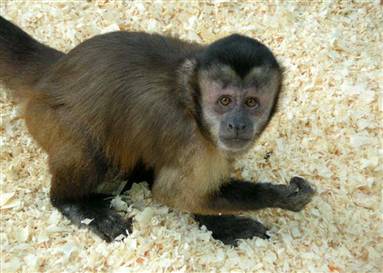
Tufted capuchin, or Brown capuchin, orBlack-capped capuchin, orPin monkey(Cebusapella, or Sapajuspaella, orCebusnigritus)
Phylum —chordata
Class — mammalia
Order — primates
Family — cebidae
Genus –sapajus
Appearance
The Tufted capuchin is more powerfully built than the other capuchins, with rougher fur and a long, thick tail. It has a bundle of long, hardened hair on the forehead that can be raised as a sort of "wig". The fur is brownish gray, with the belly being somewhat lighter-colored than the rest of the body. The hands and feet are black. The tail is prehensile: strong and can be usedfor grasping, as an extra limb.
The Tufted capuchin has a head-body length of 32 to 57 centimeters (13 to 22 in), a tail length of 38 to 56 centimeters (15 to 22 in), and a weight of 1.9 to 4.8 kilograms (4.2 to 10.6 lb), with the males generally being larger and heavier than the females.
Habitat
The area of their habitat is a huge territory, covering Amazon rainforest of the Guyanas, Venezuela and Brazil, stretching west from the Rio Negro and reaching the Orinoco in Venezuela. The habitat of Black-capped capuchins also includes eastern part and upper Andean Magdalena valley of Colombia as well as certain areas of Ecuador, Bolivia and Peru. In addition, they have been successfully introduced to Trinidad and Tobago: currently, there’s a population of Black-capped capuchins in the northeastern peninsula of Trinidad Island.
Behavior
Black-capped capuchins are diurnal. They are arboreal animals, moving quadrupedally by leaping and climbing. They are highly sociable primates, usually congregating in groups of 8-15 individuals. Social grooming is a usual activity between members of a group. The dominant male is the leader of the group, protecting it from predators as well other groups of monkeys; as soon as another group invades its home range, the dominant male leads the defense of the territory. As it comes to food and mating, the dominant male is privileged, having the right of first choice. Even in case of food shortage, when the group finds a new source of food, the dominant male always eats first.
Diet
The capuchins are omnivores, they feed upon fruit, leaves and insects. In addition, they skillfully break nuts, catch frogs and small birds. It’s even believed that the Black-capped capuchins consume small mammals.
Reproduction
The capuchins are polygamous, having a mating system where females mate primarily with the dominant male of the group. There’s no specific breeding season for the Black-capped capuchin. However, births take place mainly in dry season and during early rainy season. The period of gestation lasts 150-160 days, after which a female usually gives birth to a single baby (very rarely – twins). Parental care is generally left to the female, who feeds the young for 9 months. For several months after birth, the infant travels, clung to the fur of its mother. Males reach sexual maturity at 7 years old while females – much earlier, being able to give birth as early as 4 years old.
In captivity
In a captive case of extreme longevity, a Tufted capuchin male lived until he was at least 45 years old.
In the wild, capuchins swing from tree to tree, something that most home enclosures don't permit. The lack of natural habitat in a home setting raises much controversy regarding keeping these monkeys at all. Typically, there isn't nearly enough space or foliage in an average yard to allow the primate proper exercise.
That said, the bigger the enclosure, the better. And if you do decide to house a capuchin, make sure it has plenty of trees to swing and jump from, provide a shaded area for shelter from the elements, and be sure it's monkey-proofed. Even healthy and happy monkeys are curious, and a breakout is inevitable if given the time and an outlet.
In the wild, capuchins eat bugs, fruit, small birds, nuts, and flowers. Mimicking this monkey's natural diet in captivity can be somewhat tricky. A high-quality, formulated monkey chow provides the bulk of their nutritional needs. Ample outdoor space allows them to forage. Supplement their diet with baby food, fruits, and vegetables (cut to size). A varied diet keeps a monkey interested, especially if you hide it, and they have to search for it. It is best to feed your monkey on a regular schedule and twice per day.
Capuchins also thrive with the occasional cooked meat treat (about 1 teaspoon), but never give them table food, dairy products, or sweets, as this is not part of their natural diet and can lead to health problems.
 Russian
Russian
 English
English























